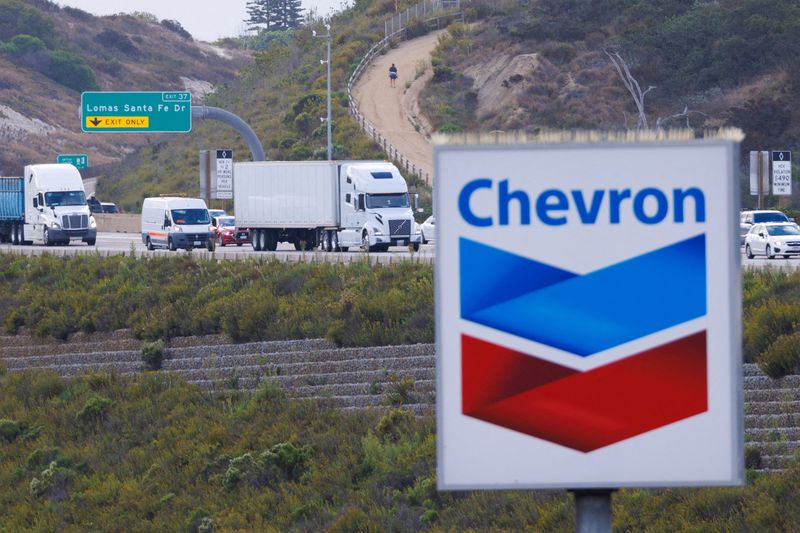
By Shariq Khan
NEW YORK (Reuters) – U.S. motorists should see gasoline prices fall below $3 a gallon for the first time in over three years as soon as next month, shortly before they go to vote in November’s presidential election, analysts said this week.
Softer gasoline prices, resulting largely from weaker fuel demand and sliding oil prices, are a relief for consumers who have struggled with record high fuel costs that have stoked inflation. Lower prices could also help Vice President Kamala Harris and other Democrats fight off sharp criticism from Republicans over pain at the pump.
As of Wednesday, the national average price for regular gasoline stood at $3.25 a gallon, down 19 cents from a month ago and 58 cents from a year ago, according to data from motorist association AAA.
The average should break below $3 a gallon by late October, if not sooner, with summer driving season over and retailers starting to sell cheaper winter-grade fuel in the weeks ahead, said Patrick De Haan, analyst at GasBuddy.com. In North Carolina, considered a swing state in the Nov. 5 presidential election, pump prices were already below $3 on Wednesday.
“Americans will definitely remember the price they see when they drive into polling stations, so this is definitely good news for Harris in her campaign for president against Republican Donald Trump,” De Haan said.
Studies by the Wells Fargo Investment Institute, among others, show U.S. presidential approval ratings are inversely tied to gasoline prices. Therefore falling prices should lift Democrats in this election cycle, said John LaForge, head of real asset strategy at the investment advisory firm.
Presidents actually have little direct influence on gasoline prices, which move based on global supply and demand fundamentals. Prices have dropped sharply this year because demand has been weaker-than-expected, especially in the U.S. and China. Global benchmark Brent crude has slid from over $90 a barrel in April to a near three-year low of under $70 on Tuesday.
A wild card is Hurricane Francine which was barreling through the U.S. offshore oil patch on Wednesday, lifting U.S. crude oil prices more than $2 a barrel on fears of lengthy production shutdowns.
In 2022, oil prices hit record highs of over $5 a gallon primarily on supply shocks following Russia’s invasion of Ukraine at a time global fuel demand was surging due to easing COVID-era lockdowns.
Supply has been more robust this year, helping lower pump prices as refiners ran at elevated rates, said Brian Kessens, senior portfolio manager at investment firm Tortoise.
U.S. gasoline demand is expected to average 8.92 million barrels per day this year, about 20,000 bpd less than last year, the U.S. Energy Information Administration (EIA) said on Tuesday. It earlier expected 2024 demand to match last year’s.
Still, that level represents 9% of global oil demand, and makes the U.S. the biggest fuel consumer in the world. That gives the dollar-per-gallon figure extra visibility in any government’s scorecard.
HARRIS BOOST
Republicans have repeatedly blamed President Joe Biden’s policies for the surge in gasoline prices and inflation during his term, but De Haan said these attacks are losing their bite because of the rapid pullback in pump prices.
Consumer prices rose 2.5% in the 12 months through August, the slowest year-on-year increase since February 2021, data from the Labor Department showed on Wednesday. The data showed gasoline prices down 10% from a year-ago, the largest annual decline since July 2023.
Gasoline prices, as measured by the Consumer Price Index, have not grown since April.
The effect of lower gasoline prices is likely to be felt most meaningfully in swing states that will ultimately decide the election, said Tom Kloza, head of energy analysis at Oil Price International Service.
Among those states, North Carolina’s average dipped to $2.983 per gallon on Wednesday, while Wisconsin was at $3.043, data from motorist association AAA showed.
Diesel prices, a less visible but arguably more important indicator of a country’s economic state, are also on a similar trajectory due to weak demand and higher supply, AAA spokesperson Andrew Gross said.
Primarily a fuel used in manufacturing and transportation of goods, higher diesel costs passed on to consumers can raise prices for everything from eggs to televisions.
The EIA on Tuesday lowered its forecast for U.S. distillate fuel demand, which includes diesel and heating oil, to 3.83 million barrels a day, about 1% below its prior forecast and a 2.3% decline from last year.

National average diesel prices slid to $3.56 a gallon by Sept. 9, down 32 cents from the start of the year and the lowest level since Oct. 2021, according to EIA data.
“Whoever the next President is, they will definitely benefit from lower fuel prices and some serious deflation,” Kloza said.
This post is originally published on INVESTING.




